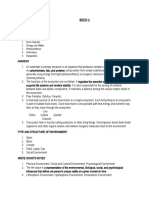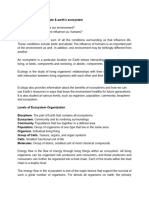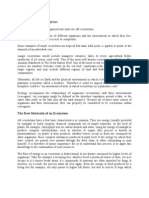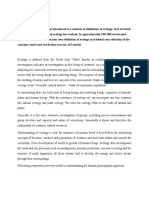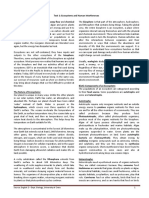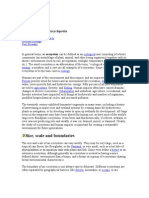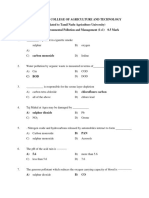Ecosystems: 3.1 Types of Ecosystems There Are Essentially Two Kinds of Ecosystems Aquatic and Terrestrial. Any
Ecosystems: 3.1 Types of Ecosystems There Are Essentially Two Kinds of Ecosystems Aquatic and Terrestrial. Any
Uploaded by
Mariia RivasCopyright:
Available Formats
Ecosystems: 3.1 Types of Ecosystems There Are Essentially Two Kinds of Ecosystems Aquatic and Terrestrial. Any
Ecosystems: 3.1 Types of Ecosystems There Are Essentially Two Kinds of Ecosystems Aquatic and Terrestrial. Any
Uploaded by
Mariia RivasOriginal Title
Copyright
Available Formats
Share this document
Did you find this document useful?
Is this content inappropriate?
Copyright:
Available Formats
Ecosystems: 3.1 Types of Ecosystems There Are Essentially Two Kinds of Ecosystems Aquatic and Terrestrial. Any
Ecosystems: 3.1 Types of Ecosystems There Are Essentially Two Kinds of Ecosystems Aquatic and Terrestrial. Any
Uploaded by
Mariia RivasCopyright:
Available Formats
ECOSYSTEMS
Ecosystems are the interactions between the living things and the nonliving things in a place. In an ecosystem, the plants, animals, and other organisms rely on each other and on the physical environment the soil, water, and nutrients, for example. Even though they are living in the same place, each species in an ecosystem has its own role to play. This role is called a niche. The niche for one species might be to climb trees and eat their fruit, while the niche for another species might be to hunt for small rodents. For a tree, a niche might be to grow tall and make food with the Suns energy through the process of photosynthesis. If the niche of two species is very similar, they might compete for food or other resources. Sometimes ecosystems get out of balance. If, for example, it rains a lot and a type of bird that thrives with extra water increases in numbers, other species in the ecosystem might be crowded out. The birds might take food or space or other resources from other species. They might eat all the food. Sometimes an ecosystem naturally gets back into balance. Other times an ecosystem will become more and more out of balance. Today, human actions are having an impact on ecosystems all over the world. Making buildings and roads, fishing and farming all have an impact on ecosystems. Pollution on land, air pollution, and water pollution is sending many ecosystems out of balance too. 3.1 Types of ecosystems There are essentially two kinds of ecosystems; Aquatic and Terrestrial. Any other sub-ecosystem falls under one of these two headings. 3.1.1Terrestrial Ecosystems: can be found anywhere apart from heavily saturated places. They are broadly classed into: The Forest Ecosystems: They are the ecosystems in which an abundance of flora, or plants, is seen so they have a big number of organisms which live in relatively small space.
The Desert Ecosystem: Desert ecosystems are located in regions that receive an annual rainfall less than 25. They occupy about 17 percent of all the land on our planet. The Grassland Ecosystem: are located in both the tropical and temperate regions of the world though the ecosystems vary slightly. The area mainly comprises grasses with a little number of trees and shrubs. A lot of grazing animals, insectivores and herbivores inhabit the grass. The two main kinds of grasslands ecosystems are: Savanna and Prairies. The Mountain Ecosystem: Mountain land provides a scattered and diverse array of habitats where a large number of animals and plants can be found. At the higher altitudes, the harsh environmental conditions normally prevail, and only the treeless alpine vegetation can survive. 3.1.2 Aquatic Ecosystems: The aquatic ecosystem is the ecosystem found in a body of water. It encompasses aquatic flora, fauna and water properties, as well. There are two main types of aquatic ecosystem - Marine and Freshwater. The Marine Ecosystem: Marine ecosystems are the biggest ecosystems, which cover around 71% of Earth's surface and contain 97% of out planet's water. Water in Marine ecosystems features in high amounts minerals and salts dissolved in them. The Freshwater Ecosystem: Contrary to the Marine ecosystems, the freshwater ecosystem covers only 0.8% of Earth's surface and contains 0.009% of the total water. Three basic kinds of freshwater ecosystems exist: Lentic, Lotic and Wetlands. 3.2 Photosynthesis A great variety of living things on earth, including all green plants, synthesize their foods from simple molecules, such as carbon dioxide and water. For this process, the organisms require energy, and that energy is derived from sunlight. Photosynthesis is the process of converting light energy to chemical energy and storing it in the bonds of sugar. This process occurs in plants and some algae (Kingdom Protista). Plants need only light energy, CO2, and H2O to make sugar. The process of photosynthesis takes place in the chloroplasts, specifically using chlorophyll, the green pigment involved in photosynthesis.
Photosynthesis takes place primarily in plant leaves, and little to none occurs in stems, etc. The parts of a typical leaf include the upper and lower epidermis, the mesophyll, the vascular bundle(s) (veins), and the stomates. The upper and lower epidermal cells do not have chloroplasts, thus photosynthesis does not occur there.
3.3 Chemistry of Photosynthesis Light energy is captured in the chloroplast of plant cells and used to synthesize glucose molecules, shown as C6H12O6. In the process, oxygen (O2) is released as a waste product. The glucose and oxygen are then used in the mitochondrion of the plant and animal cell, and the energy is released and used to fuel the synthesis of ATP from ADP and P. In the reaction, C02 and water are released in the mitochondrion to be reused in photosynthesis in the chloroplast. The process of utilizing energy to synthesize carbohydrate molecules is referred to as photosynthesis. Photosynthesis is actually two separate processes. In the first process, energy-rich electrons flow through a series of coenzymes and other molecules. This electron energy is trapped. During the trapping process, adenosine triphosphate (ATP) molecules and molecules of nicotinamide adenine dinucleotide phosphate hydrogen (NADPH) are formed. Both ATP and NADPH are rich in energy. These molecules are used in the second half of the process, where carbon dioxide molecules are bound into carbohydrates to form organic substances such as glucose. The overall chemical reaction involved in photosynthesis is: 6CO2 + 6H2O (+ light energy) C6H12O6 + 6O2. This is the source of the O2 we breathe, and thus, a significant factor in the concerns about deforestation.
CONCLUSIONS
1. An ecosystem is very important because it is the community of living things where they develop their life processes.
2. An ecosystem may lose its balance by the neglect of human actions.
3. A plant can synthesize their food from a process that just requires sun light and its call photosynthesis.
4. Photosynthesis is essential for there to be an ecosystem.
5. Chemistry is important because it helps to understand the effects of photosynthesis in ecosystems and it describes the process reaction.
ANNEXES
1. Crowded: Concurrido / Lleno de animales, gente etc.
2. Headings: Encabezamientos.
3. Heavily: Fuertemente.
4. Pollution: Polucin, Contaminacin
5. Rely: Confiar
6. Resources: Recursos
7. Scattered: Disperso
8. Shrubs: Arbustos
9. Slightly: Ligeramente
10. Stems: Deriva
11. Thrives: Prospera
12. Thus: As
REFERENCES
1.
CLIFFSS NOTES. Photosynthesis Defined. (On line). Clifton Keith Hillegass. Nebraska, 2010. Consulted in: 23 October 2012. Available on <http://www.cliffsnotes.com/study_guide/PhotosynthesisDefined.topicArticl eId-8741,articleId-8596.html>>
2.
ECOSYSTEM. ORG. Different types of ecosystems. (On line). Daniela Paley. Los Angeles, 2012. Consulted in: 23 October 2012. Available on: <http://www.ecosystem.org/types-of-ecosystems>>
3.
SCLINKS. Photosynthesis. (On line). J. Stein Carter. Menlo Park, CA. 2004. Consulted in: 23 October 2012. Available on: <<http://biology.clc.uc.edu/ courses/bio104/photosyn.htm>>
4. WINDOWS TO UNIVERSE. Biomes and ecosystems. (On line). Lisa Gardiner. Orlando Fl. 2008. Consulted in: 23 October 2012. Available on: <<http://www.windows2universe.org/earth/ecosystems.html>>
You might also like
- Sustainable EcosystemsDocument5 pagesSustainable EcosystemsbobNo ratings yet
- Class 10 Science Chapter 15 Our Environment Revision NotesDocument23 pagesClass 10 Science Chapter 15 Our Environment Revision Notesindonesiaserver3150No ratings yet
- Science Environment ReportDocument17 pagesScience Environment ReportThuc TrinhNo ratings yet
- Social EnvironmentDocument3 pagesSocial EnvironmentMary Jane AndesNo ratings yet
- Ecosystem: Department of Environmental Science, Pub Kamrup CollegeDocument8 pagesEcosystem: Department of Environmental Science, Pub Kamrup CollegeDebajit SarmaNo ratings yet
- Ecosystems IDocument2 pagesEcosystems IGalido Maybelyn G.No ratings yet
- Ecosystems: I. What Is An Ecosystem?Document5 pagesEcosystems: I. What Is An Ecosystem?AntonioNo ratings yet
- Module 1 EcosystemDocument8 pagesModule 1 EcosystemVidhyashree YadavNo ratings yet
- Untitled DocumentDocument18 pagesUntitled DocumentKAYE EVANGELISTANo ratings yet
- M9 - Reading WorksheetDocument8 pagesM9 - Reading WorksheetCindy Lacsita Difa0% (1)
- ECOSYSTEM bio 12Document7 pagesECOSYSTEM bio 12bsrevathi21No ratings yet
- Ecosystem Group 1Document27 pagesEcosystem Group 1Bea Marie OyardoNo ratings yet
- Ecosystems: A Description: The Raw Materials of An EcosystemDocument8 pagesEcosystems: A Description: The Raw Materials of An EcosystemMonasterio Tan KennethNo ratings yet
- What Is An EcosystemDocument4 pagesWhat Is An EcosystemFasika AbebayehuNo ratings yet
- Ecosystem Kinds and ImportanceDocument22 pagesEcosystem Kinds and ImportanceczarminabarriosNo ratings yet
- Forest EcosystemDocument5 pagesForest Ecosystem6jxtyryc5dNo ratings yet
- EcologyDocument13 pagesEcologyFatimah KhanNo ratings yet
- Protecting Ecosystem servicesDocument31 pagesProtecting Ecosystem serviceschavvaanithareddy18No ratings yet
- Environmental Engineering Chapter 1 For PrintDocument17 pagesEnvironmental Engineering Chapter 1 For PrintMike ian MercadoNo ratings yet
- CHAPTER 3 EcosystemsDocument20 pagesCHAPTER 3 EcosystemsFang LeoneNo ratings yet
- EcosysytemDocument32 pagesEcosysytemNandini JaganNo ratings yet
- Ecology:: Environment and Pollution Dept. Applied Ecology-Lecture No. 1 Instructor: Ola TareqDocument7 pagesEcology:: Environment and Pollution Dept. Applied Ecology-Lecture No. 1 Instructor: Ola Tareqstar of skyNo ratings yet
- Week 2 - Text 1. Ecosystems and Human InterferencesDocument2 pagesWeek 2 - Text 1. Ecosystems and Human Interferences458 269 Cinta Alivia AthaNo ratings yet
- EcosystemDocument7 pagesEcosystemHamza Khan100% (1)
- Environmental Science Questions and AnswersDocument30 pagesEnvironmental Science Questions and Answersabdulmuqtadir385No ratings yet
- ReviewerDocument7 pagesReviewerTristan BaceraNo ratings yet
- An Ecosystem is-WPS OfficeDocument7 pagesAn Ecosystem is-WPS OfficeAsterism LoneNo ratings yet
- Bio SHHWDocument15 pagesBio SHHWrishika000162No ratings yet
- ARK-Lecture - Basic Concepts-Ecology & EcosystemDocument20 pagesARK-Lecture - Basic Concepts-Ecology & EcosystemSUDEEPTA CHANDRA PAULNo ratings yet
- Concept of An EcosystemDocument6 pagesConcept of An EcosystemMrigendra MishraNo ratings yet
- Ecology Ernst Haeckel in 1869: Species Living Together in The Same Area Ex. Human Population. in TurnDocument10 pagesEcology Ernst Haeckel in 1869: Species Living Together in The Same Area Ex. Human Population. in TurnJo-ann SuyatNo ratings yet
- Our EnvironmentDocument3 pagesOur Environmentvalorishabh85No ratings yet
- Nov, 02 Last Out Put On Tuesdaydifferentiate Between Photosynthesis andDocument2 pagesNov, 02 Last Out Put On Tuesdaydifferentiate Between Photosynthesis andJosua SaysonNo ratings yet
- ECOSYSTEMDocument23 pagesECOSYSTEMVenkatesh KumarNo ratings yet
- EVS UNIT- 1 NotesDocument15 pagesEVS UNIT- 1 NotesSseieprNo ratings yet
- Unit 2_Ecosystem_Book2_231127_212510Document20 pagesUnit 2_Ecosystem_Book2_231127_212510bhavishya122112No ratings yet
- ECOSYSTEMSDocument42 pagesECOSYSTEMSJohn michael Del rosarioNo ratings yet
- SUSTAINABILITY OF ENVIRONMENT - WatermarkDocument12 pagesSUSTAINABILITY OF ENVIRONMENT - WatermarkHardik ChauhanNo ratings yet
- Atmosphere: LithosphereDocument6 pagesAtmosphere: LithosphereNandini TariyalNo ratings yet
- Ecosystem NotesDocument6 pagesEcosystem Notesbinithar32No ratings yet
- Unit 6 EcologyDocument6 pagesUnit 6 Ecologycodz5321No ratings yet
- Fold 2Document11 pagesFold 2pratik.kotechaNo ratings yet
- Ecosystem MidtermDocument27 pagesEcosystem Midtermcarlstephencaoile34No ratings yet
- English MediumDocument8 pagesEnglish MediumnewzealandcitykNo ratings yet
- Our Environment Chapter'sDocument16 pagesOur Environment Chapter'sPratik ChavanNo ratings yet
- OUR ENVIRONMENT QNS (1)Document4 pagesOUR ENVIRONMENT QNS (1)prarthana.1610No ratings yet
- GE3451Document65 pagesGE3451Everbloom EverbloomNo ratings yet
- Ge 15 Reviewer 1 3Document5 pagesGe 15 Reviewer 1 3LORRAINE ANNE LAURENTENo ratings yet
- Ecosystem: Size, Scale and BoundariesDocument5 pagesEcosystem: Size, Scale and BoundariesGaurav YadavNo ratings yet
- Ecosystems: We're All in This TogetherDocument2 pagesEcosystems: We're All in This TogetherISABELNo ratings yet
- UNIT-2 ECOSYSTEMDocument20 pagesUNIT-2 ECOSYSTEMsukrampal285No ratings yet
- Basics of EcologyDocument15 pagesBasics of Ecologychoudhary2k8100% (1)
- Module - 1 (21CIV57 & 18CIV59)Document26 pagesModule - 1 (21CIV57 & 18CIV59)Meghana GowdaNo ratings yet
- OUR ENVIRONMENT NOTES CLASS 10Document16 pagesOUR ENVIRONMENT NOTES CLASS 10beedishreyas70No ratings yet
- Our Environment (Prashant Kirad)Document44 pagesOur Environment (Prashant Kirad)anmolrxj07No ratings yet
- Abiotic and Biotic Components Free Essay ExampleDocument5 pagesAbiotic and Biotic Components Free Essay ExampleEnash RidNo ratings yet
- EcosystemDocument9 pagesEcosystemkhushianand183No ratings yet
- Handout - Energy Flow in The EcosystemsDocument9 pagesHandout - Energy Flow in The Ecosystems2021308311No ratings yet
- Foundations of Terrestrial Ecosystems: The Earth's Web, #1From EverandFoundations of Terrestrial Ecosystems: The Earth's Web, #1No ratings yet
- Get (eBook PDF) The Global Casino: An Introduction to Environmental Issues 6th Edition free all chaptersDocument56 pagesGet (eBook PDF) The Global Casino: An Introduction to Environmental Issues 6th Edition free all chapterssezingore100% (2)
- Combined NRCSDocument850 pagesCombined NRCSAnwar AdemNo ratings yet
- 1 Residential Unit: Project-The Uptown Sec-66 GGN Haryana Sub-Water Requirement CalculationDocument2 pages1 Residential Unit: Project-The Uptown Sec-66 GGN Haryana Sub-Water Requirement CalculationSOUMYA BHATTNo ratings yet
- Summary Notes - Topic 19 Organisms and Their Environment - CAIE Biology IGCSEDocument5 pagesSummary Notes - Topic 19 Organisms and Their Environment - CAIE Biology IGCSESara AbdelfattahNo ratings yet
- UPSC Prelims 2020 (Paper - II) QuestionDocument34 pagesUPSC Prelims 2020 (Paper - II) Questionanjali singhNo ratings yet
- UAE SST Resource - Term 1 - Week 7 To 9 - Natural Resources in The UAE - EditedDocument4 pagesUAE SST Resource - Term 1 - Week 7 To 9 - Natural Resources in The UAE - Editedtifokif363No ratings yet
- Cycles WorksheetDocument4 pagesCycles WorksheetJenniferNo ratings yet
- Surface Runoff HarvestingDocument3 pagesSurface Runoff HarvestingRohan GilaniNo ratings yet
- InterviewDocument4 pagesInterviewsatyamsinghaqNo ratings yet
- MSDS Strata Bond W S Comp A 2020-09-03 enDocument7 pagesMSDS Strata Bond W S Comp A 2020-09-03 encarlos_salas80No ratings yet
- Status of Mangroves and Faunistic Components in Vanishing Island, IslandDocument15 pagesStatus of Mangroves and Faunistic Components in Vanishing Island, IslandMaam Katryn TanNo ratings yet
- Environmental Science Module 3Document2 pagesEnvironmental Science Module 3Fonzy RoneNo ratings yet
- An Ecological Approach To Environmental ProblemsDocument2 pagesAn Ecological Approach To Environmental ProblemssantiagoNo ratings yet
- Ens 301 0.5 MarkDocument16 pagesEns 301 0.5 Marknaveenssince04122002No ratings yet
- 5-Retention PondsDocument7 pages5-Retention PondsBondoc, Miles Jerome Z.No ratings yet
- Study of Storm and Sewer Drains For Rajarhat (Ward No 4) in West Bengal Using Sewergems SoftwareDocument47 pagesStudy of Storm and Sewer Drains For Rajarhat (Ward No 4) in West Bengal Using Sewergems SoftwareRuben Dario Posada BNo ratings yet
- Environmental Problem Effects On The Environment Effects On The People'S HealthDocument16 pagesEnvironmental Problem Effects On The Environment Effects On The People'S HealthEilinre OlinNo ratings yet
- MicroClear Membrane Technology-BrochureDocument5 pagesMicroClear Membrane Technology-BrochureXuân HoàngNo ratings yet
- What Are: Concept of Wetlands WetlandDocument2 pagesWhat Are: Concept of Wetlands WetlandSabaperve nNo ratings yet
- DLP in Science (Different Sources of Water)Document6 pagesDLP in Science (Different Sources of Water)solivalhovelyNo ratings yet
- Green Building CoceptDocument16 pagesGreen Building CoceptSHREYA SHETTYNo ratings yet
- Company Profile - OMTCDocument12 pagesCompany Profile - OMTCSumit KumarNo ratings yet
- Water Pollution: Iliev IrinaDocument40 pagesWater Pollution: Iliev IrinaIliev IrinaNo ratings yet
- Hydro Chapter 9Document2 pagesHydro Chapter 9Roel SebastianNo ratings yet
- Nguyen Khuong DuyDocument4 pagesNguyen Khuong DuyNguyễn Khương DuyNo ratings yet
- Section 3 CompleteDocument40 pagesSection 3 Completeyared makonnenNo ratings yet
- Note 7 Quality & Environmental Cost ManagementDocument1 pageNote 7 Quality & Environmental Cost ManagementMichaela AntecristoNo ratings yet
- People and Earths EcosystemDocument4 pagesPeople and Earths EcosystemJolina T. OrongNo ratings yet
- Flood Risk Management Research and Practice 2008Document334 pagesFlood Risk Management Research and Practice 2008tahaelnourNo ratings yet
- Envi ToxicologyDocument12 pagesEnvi ToxicologyJeanetteNo ratings yet



